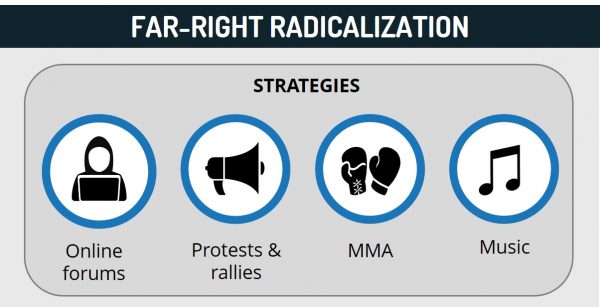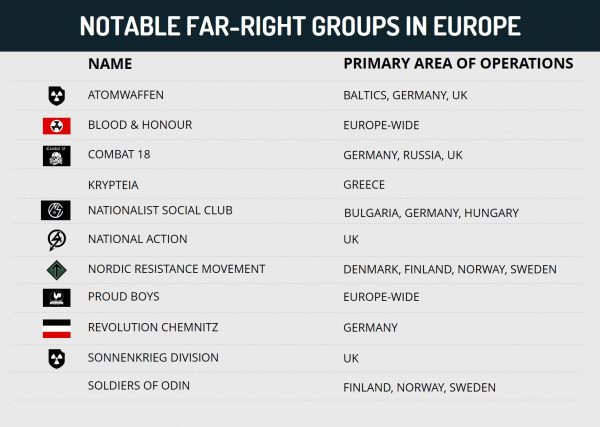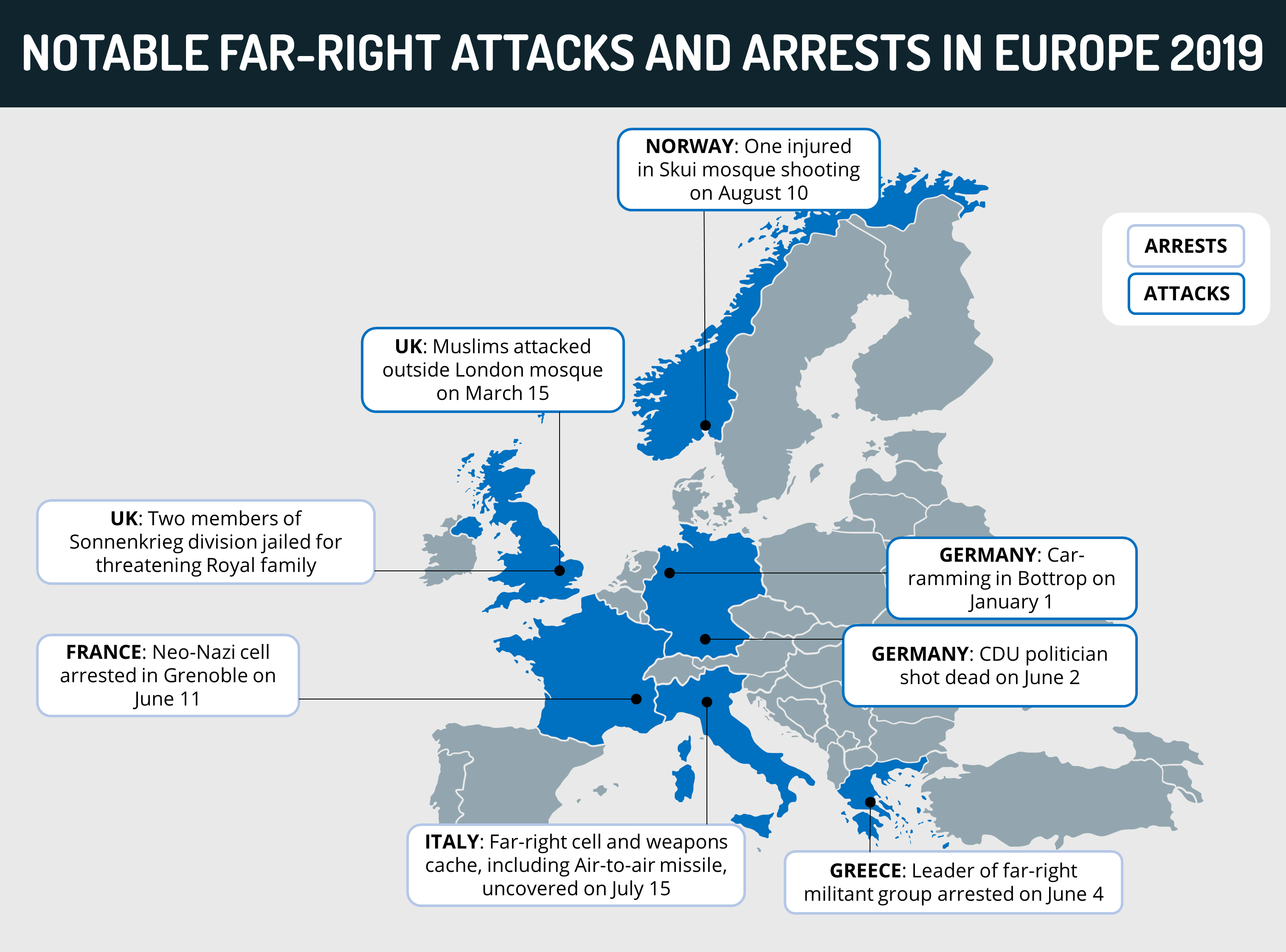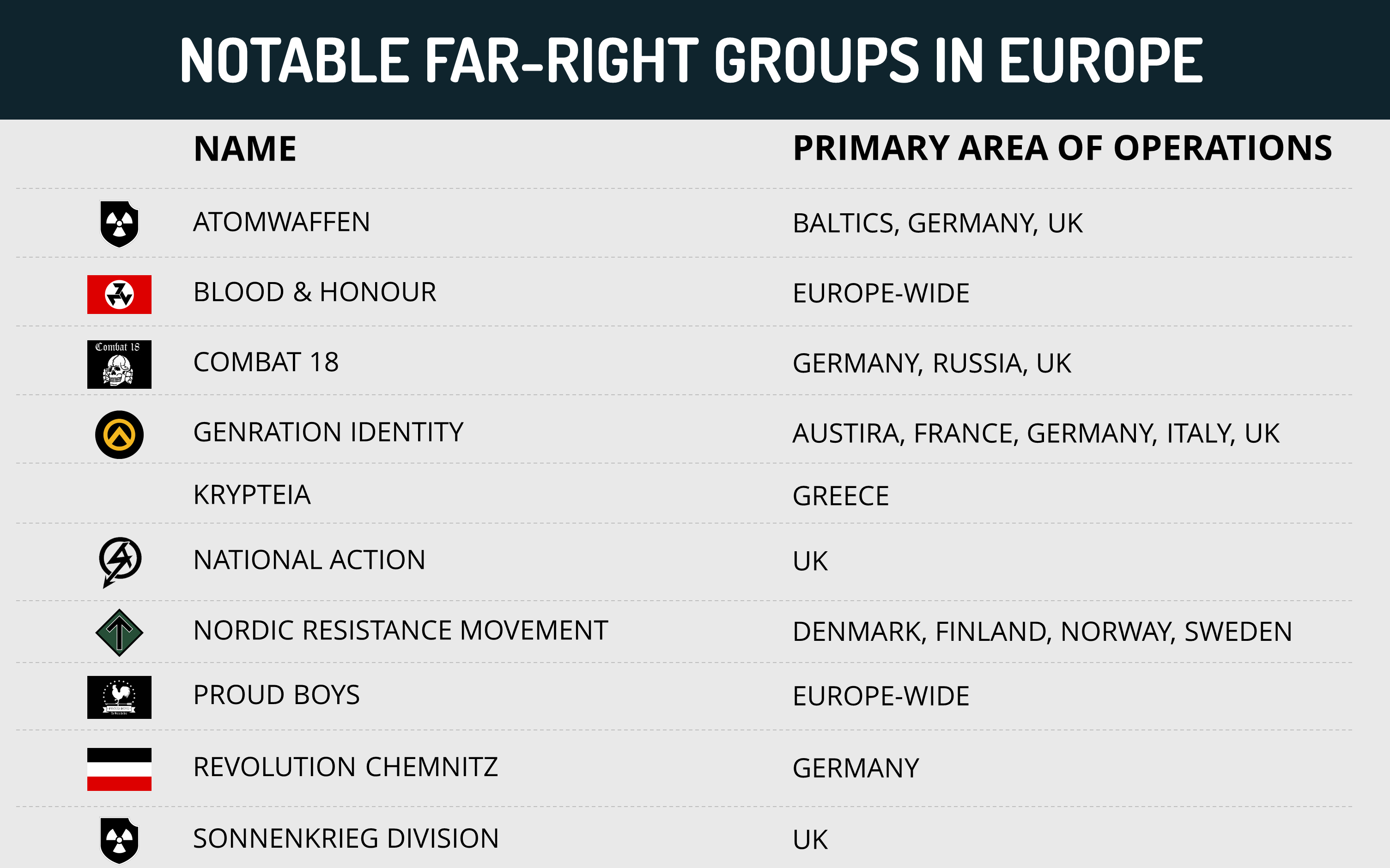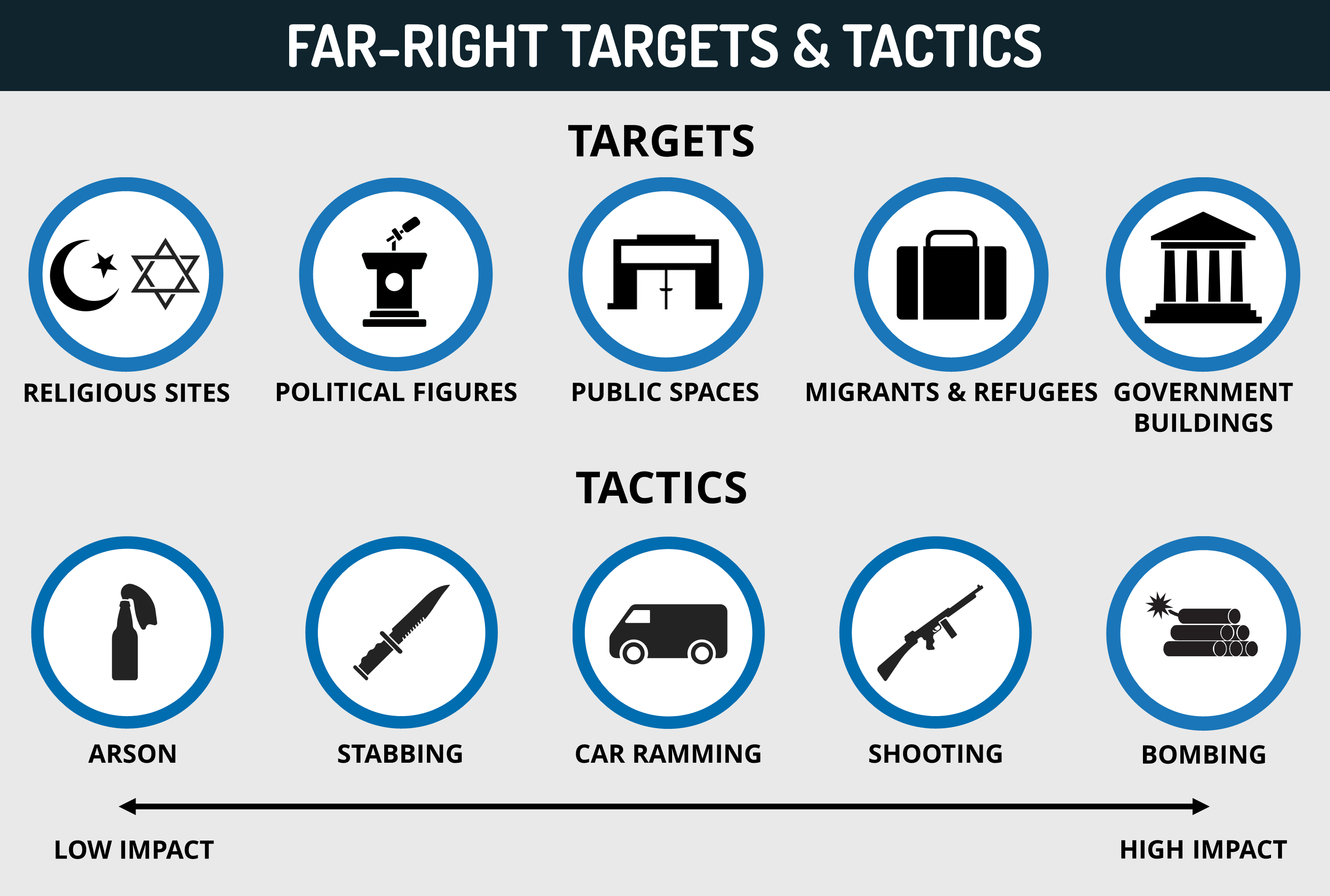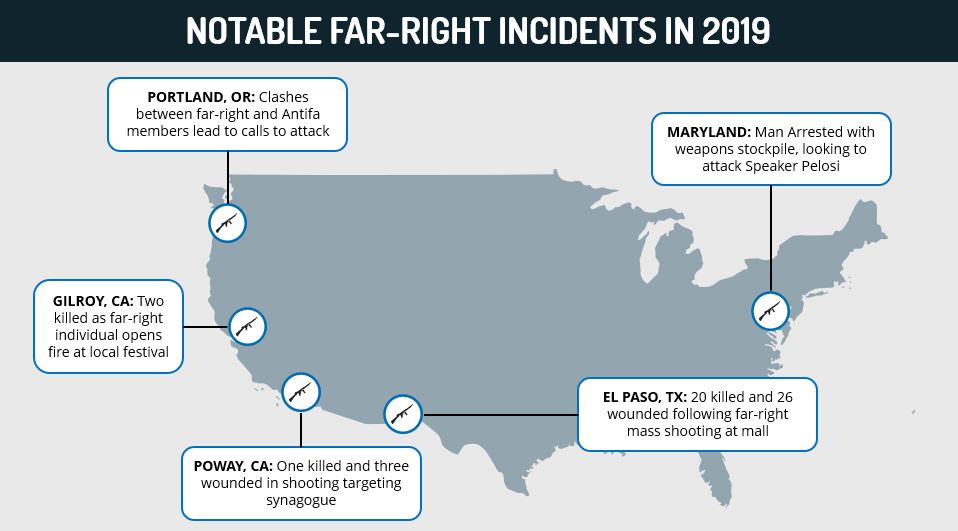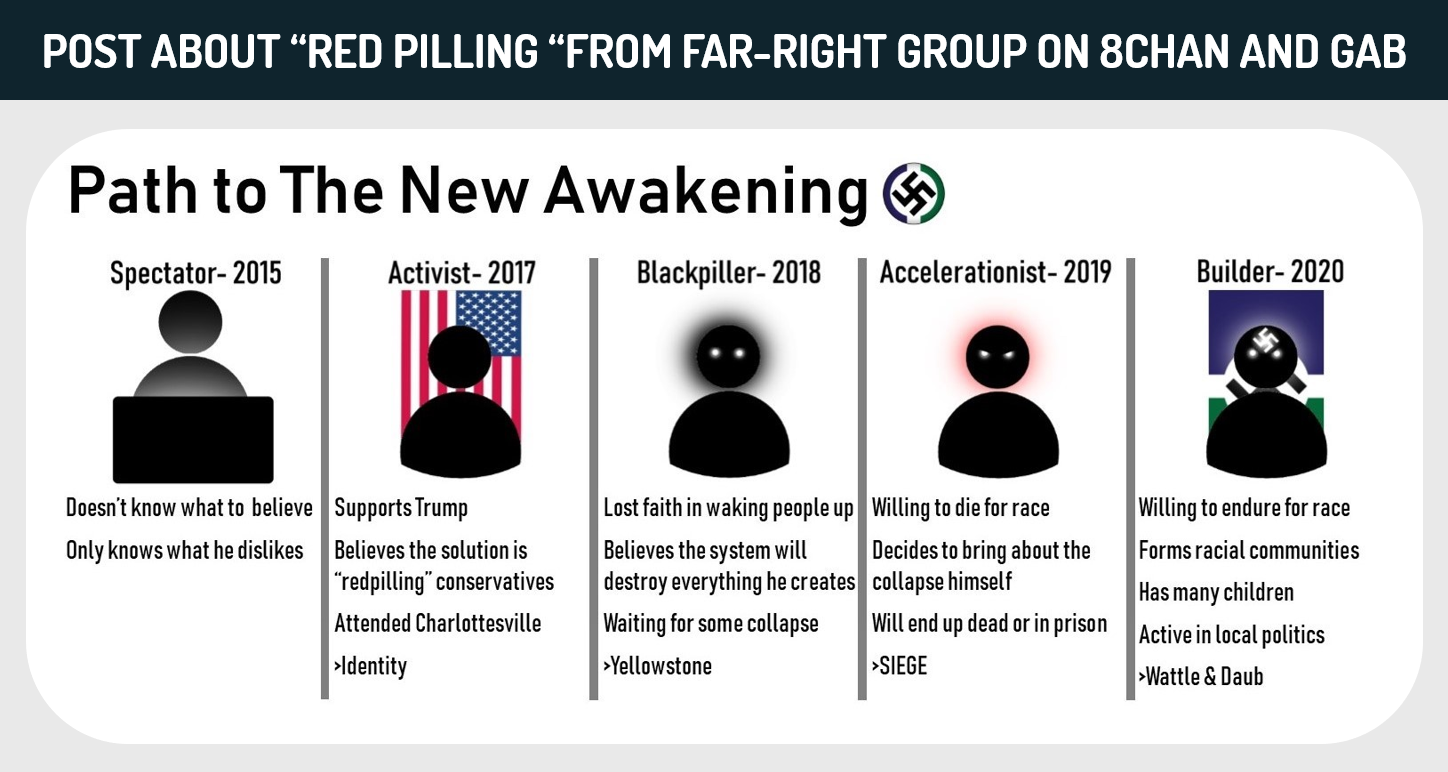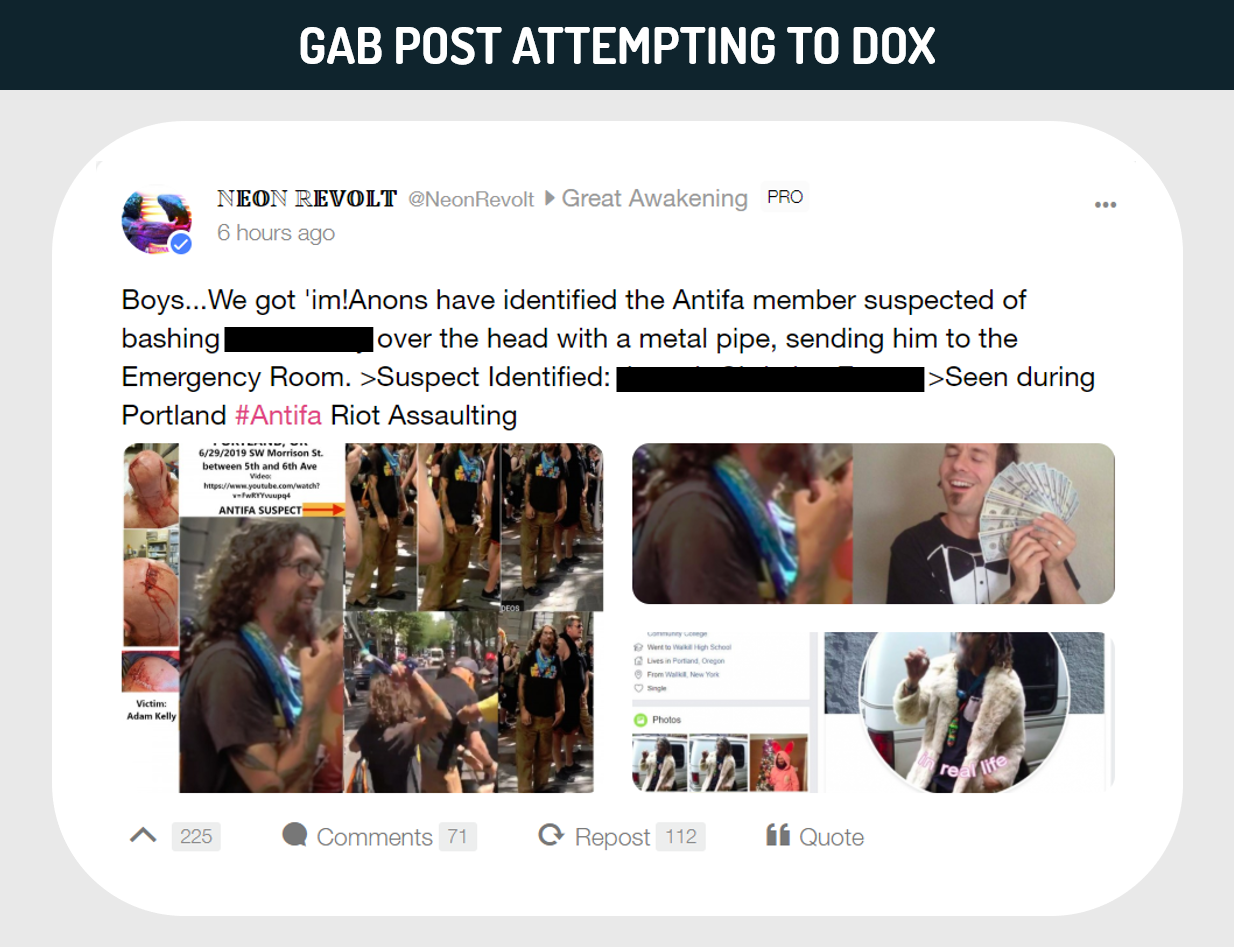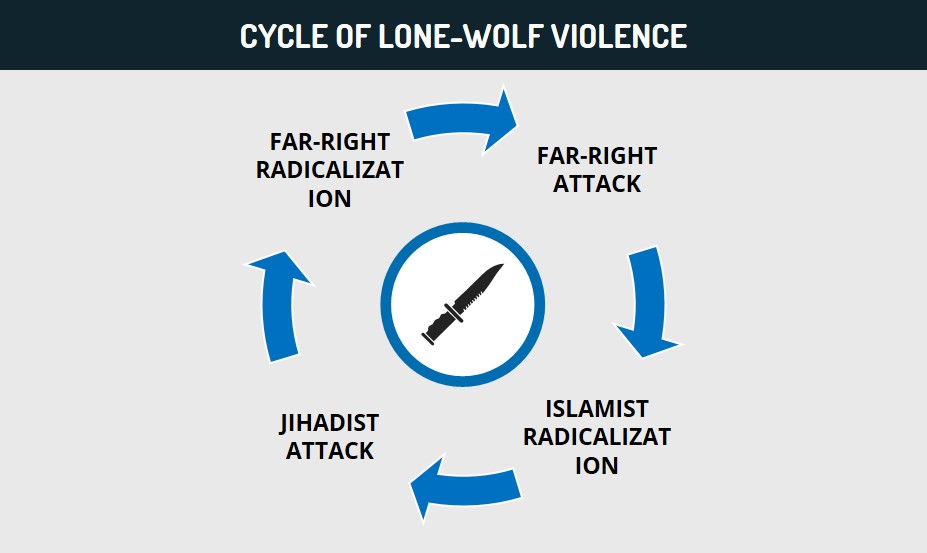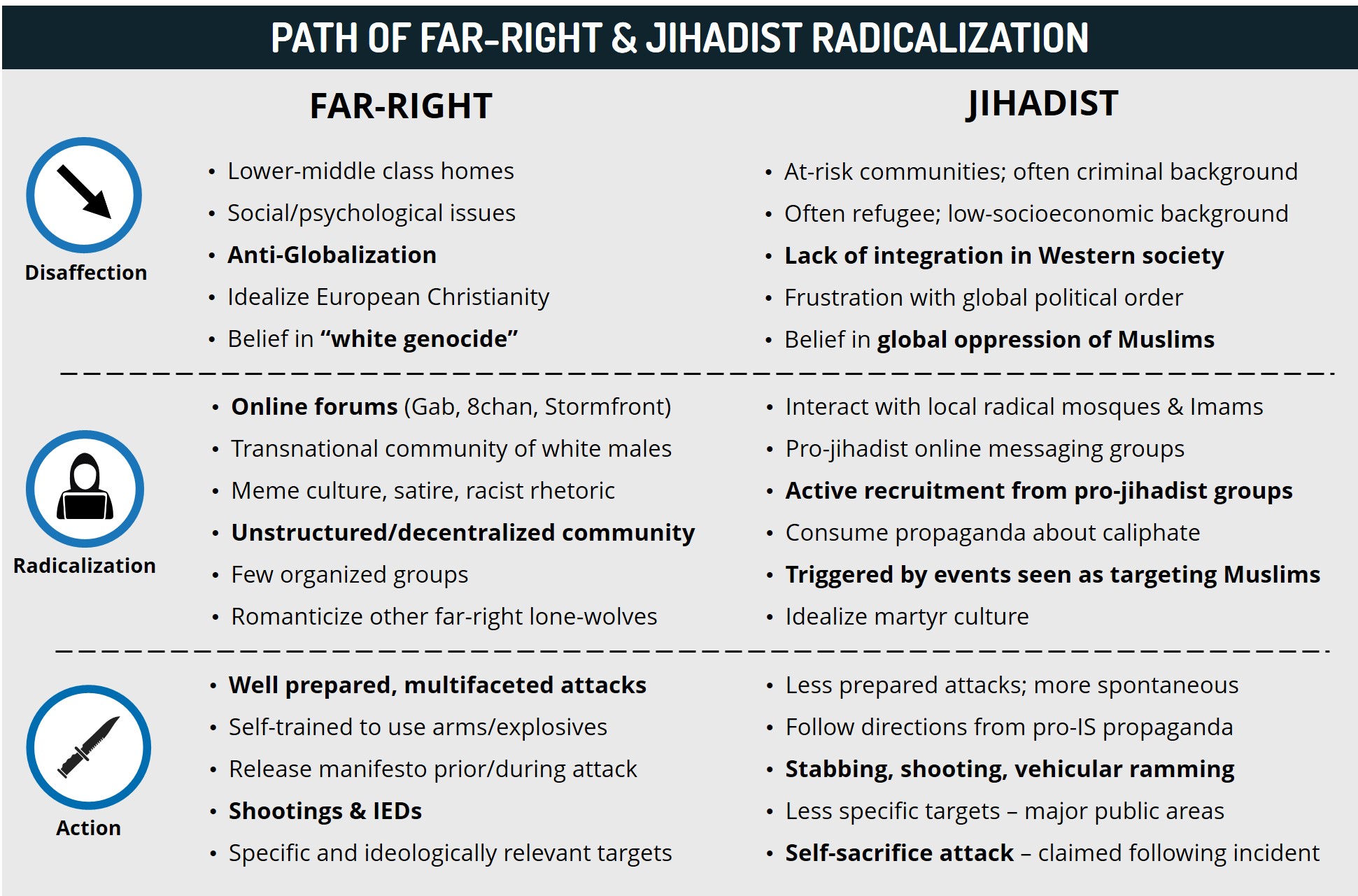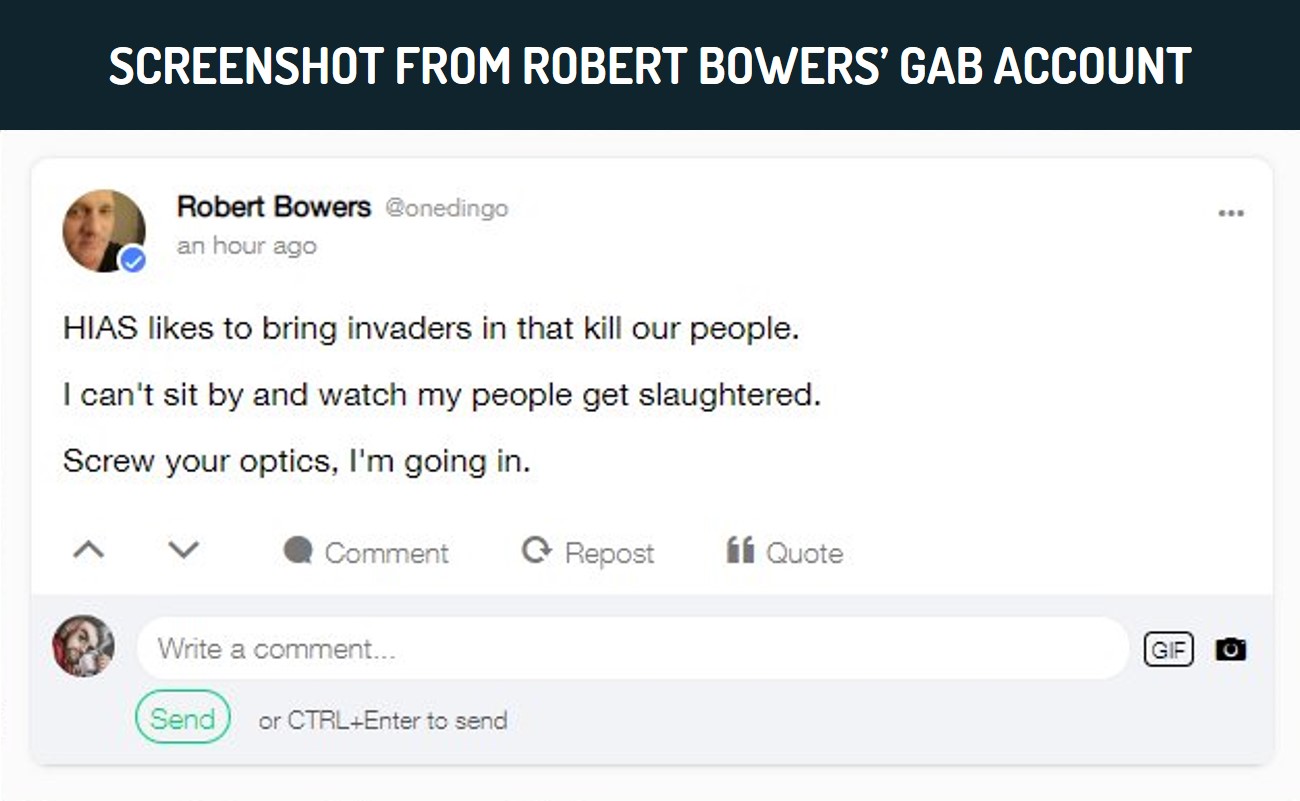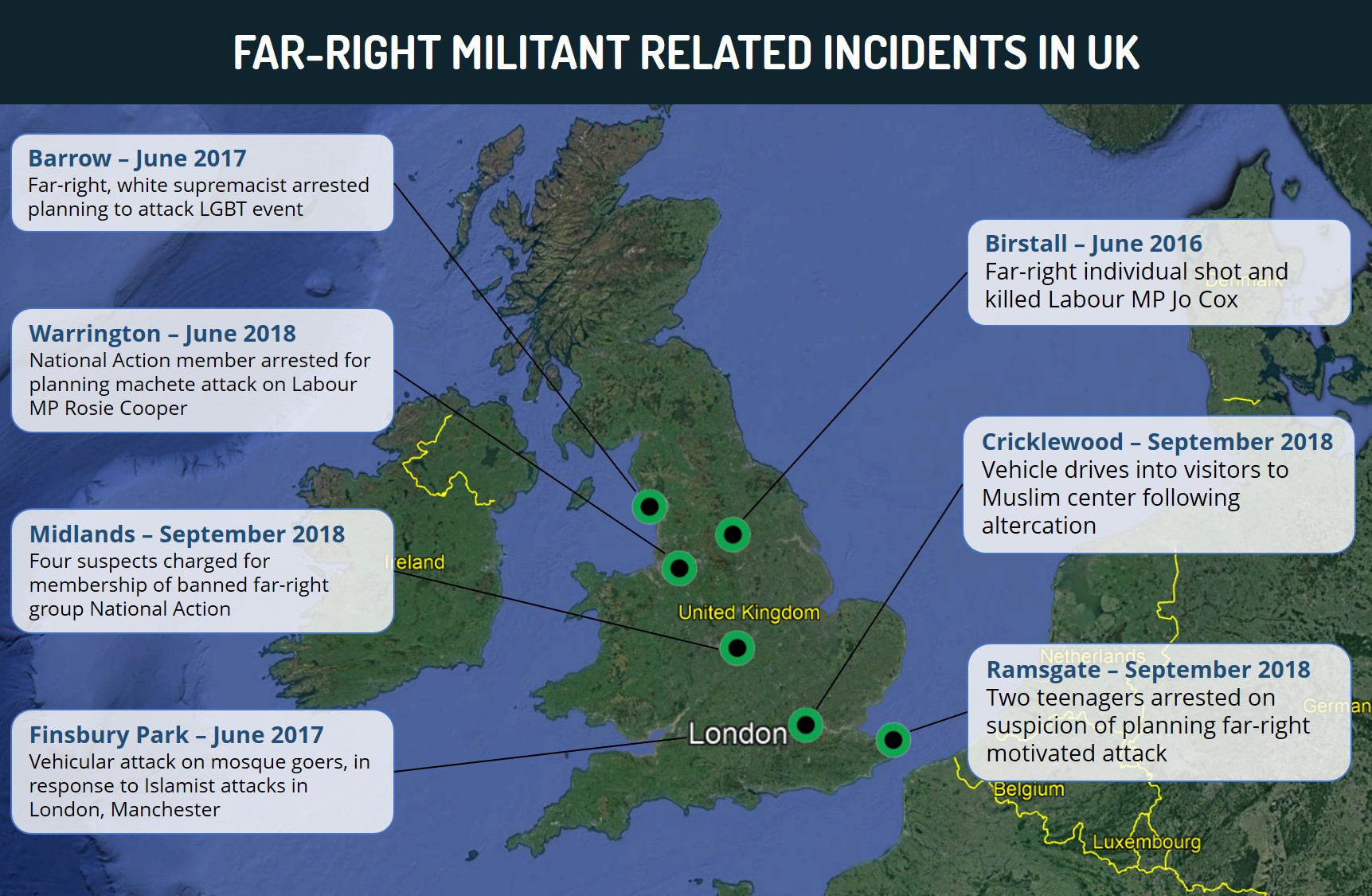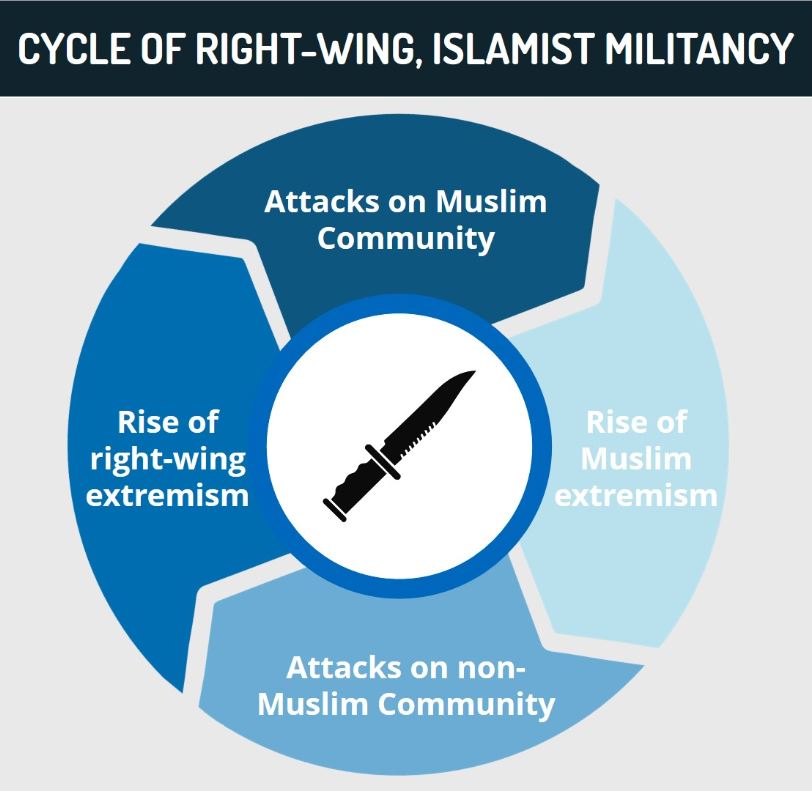Executive Summary:
- While successful far-right militant attacks have decreased in 2020, Europe continues to see significant levels of radicalization.
- A number of arrests and investigations have been made among law enforcement and security forces, as far-right extremists continue to attempt to gain access to training, weapons, and highly trained recruits.
- Far-right extremists are capitalizing on COVID-19-related grievances, infiltrating anti-lockdown protests and rallies in an attempt to become more visible and push their agenda.
- Radicalization among children and youth has seen a significant increase during COVID-19, as far-right groups target vulnerable individuals, both online and through physical events.
- The development of transnational links among far-right groups across the region has heightened the risk of far-right militant attacks.
- While extremist groups are increasingly likely to attempt large scale coordinated attacks and campaigns, radicalized lone wolf attackers are still more likely to succeed due to lesser surveillance.
- Travel to Europe may continue while maintaining vigilance for militant-related activity.
Current situation
Notable Far-right Incidents in Europe
- Europe has witnessed a number of notable incidents linked to the far-right in 2020:
- On December 12, Austrian authorities seized dozens of weapons, explosives, and 100,000 rounds of ammunition that were intended to be used to set up an armed far-right extremist militia in Germany’s southern state of Bavaria. Five suspects were arrested in Austria and two in Bavaria.
- On December 10, two individuals were arrested in Andalusia and Navarre in Spain for selling drugs to buy weapons to instigate a “future race war,” a focal point in white supremacist ideology.
- On October 4, a Jewish student was seriously injured in an attack outside a synagogue in Hamburg. The assailant wore military-style clothing, similar to that of the German army. A note with a swastika was found in the suspect’s possession.
- On February 19, eleven people were killed and five injured in a far-right attack at two shisha bars in Hanau, Germany. The perpetrator, Tobias Rathjen, published his manifesto online, purporting right-wing extremist views and expressing hatred for migrants.
Far-Right Radicalization in 2020
- Far-right radicalization in Europe in 2020 has seen a shift in trends as a result of the COVID-19 pandemic. Such reports have found that far-right extremists are using the COVID-19 pandemic to purport conspiracy theories and disinformation on social media. Major theories have included the claim that COVID-19 is a bioweapon, that the pandemic was orchestrated to influence US politics, and that COVID-19 was created by Big Pharma to push a mass vaccination program. Central figures targeted by these theories have included George Soros and Bill Gates. Moreover, the pandemic is being used to repurpose pre-existing extremist tropes as an opportunity to attack a range of minority communities. In addition to theories claiming that the virus was created by the “Jewish elite,” others claim that migrants brought COVID-19 to Europe, exacerbating existing anti-migrant sentiments.
- In October, Germany released its first nationwide report on right-wing extremism in the security services, revealing hundreds of related incidents across the police and military. In total, there were 1,064 cases among military personnel and 370 incidents among police and intelligence officers between January 2017 and March 2020. On December 9, German intelligence agents in Baden-Wuerttemberg put the Querdenken 711 group, which has organized and participated in anti-lockdown protests, on a watch-list due to its links to far-right extremism and growing concerns regarding radicalization.
- On December 5, Spain’s Defense Minister Margarita Robles called on the Prosecutor’s Office to open an investigation on an online chat group in which retired military officials appeared to be disseminating far-right content, including support for military uprisings and mass executions
- In December 2020, the UK released a report stating that a total of 17 under 18-year-olds have been arrested for militancy related charges between January and the end of September 2020, compared to 11 in 2019. The number of referrals of right-wing extremist content rose by 43 percent between 2019 and 2020. Nearly 1,500 children aged 15 and under have been identified as being at risk of radicalization. A total of 682 children were referred to the government’s counter-terrorism program over concerns about their involvement with the far-right in 2017-2018. The figure shows a five-fold increase since 2014-15. Of the 682 children, 24 were under the age of ten. In total, the government recorded 1,404 referrals related to right-wing radicalization, 62 percent of which were related to individuals under the age of 20.
- In May, the Council of the European Union issued a report on far-right extremist groups exploiting the COVID-19 pandemic to radicalize, recruit, and fundraise for their cause. Similar reports were issued by the United Nations in April.
Assessments & Forecast
Far-right groups are using COVID-19 to repurpose existing narratives and enter the mainstream
- That far-right extremists are infiltrating anti-lockdown protests and rallies throughout Western Europe, as evidenced by extremists attending protests in Germany, Spain, and the UK, indicates such groups are taking advantage of COVID-19 related anxieties and grievances in the public to become more visible and push their agenda. This is evident by far-right groups criticizing COVID-19 restrictions, particularly reimposed lockdowns during the second wave of the pandemic, as well as concerns regarding COVID-19 vaccines, to undermine government officials.
- Considering that anti-lockdown protests have witnessed unrest, including clashes, these demonstrations present a threat to bystanders. Most notably, these anti-lockdown protests hold a high potential for radicalization. This was evident in the German region of Baden-Wuerttemberg’s decision to put the Querdenken 711 group under surveillance due to its ties to the far-right and increasing risk of radicalization.
- The dissemination of COVID-19-related conspiracy theories and disinformation online reiterates the continued use of online platforms by far-right extremists to purport their ideologies. That discussions of far-right conspiracy theories related to COVID-19 have surged, with one major social media platform seeing posts increase by 815 percent and another by 750 in March alone, further suggests far-right groups are capitalizing on public concerns. Given that many of these posts do not appear to be overtly far-right in nature, with a significant number focusing on lockdown measures and anti-government sentiments, the pandemic has allowed far-right extremists to increase their public base as well as their exposure, with the content being increasingly shared and normalized online. Further, far-right extremists globally are utilizing similar COVID-19-related conspiracy theories, allowing movements to form transnational links and share strategies.
- FORECAST: As lockdowns are eased, and countries begin to roll out mass vaccination programs, it is likely that far-right extremists will increase discourse on vaccinations, with disinformation and protests related to COVID-19 vaccines expected to increase. Governments are likely to increase surveillance among groups and forums sharing such information in the near term, as well as potentially restrict related protests and rallies, due to the potential for being hotbeds of radicalization.
Far-right extremist groups to increase membership base by appealing to vulnerable groups both online and through physical events
- Reports by law enforcement agencies regarding increased radicalization among children and youth indicate that far-right extremists are utilizing various strategies aimed at recruiting children. In particular, online strategies, such as first-person shooting video games, videos, and online forums, are providing vulnerable individuals with a sense of belonging. Given that the pandemic has exacerbated grievances and led to an increase in internet usage, the risk for radicalization among vulnerable segments of the population has risen.
- The widespread use of remote teaching since March has resulted in less monitoring, both with regard to online activity and changes in behavior among youth. With that, the pandemic has not only increased the potential for radicalization but also the ability to monitor such activity. In the UK, the closures of schools and reductions in social care and mental health provision have led to a decrease in referrals to police about possible radicalization for the country’s PREVENT counter-terrorism program.
- In addition to online tactics, far-right extremist groups continue to focus on violent sports, particularly mixed martial arts (MMA), as well as music and music festivals. Given MMA’s general popularity, the far-right’s use of the sport offers an ideal recruitment tactic, with MMA events serving as fundraising and propaganda dissemination opportunities.
- Considering that these events, such as the white supremacist Shield and Sword MMA festival held in Ostritz, Germany, as well as music festivals regionwide, are often attended by individuals from multiple countries, they provide far-right groups with the possibility of forming transnational links.
- FORECAST: As COVID-19 related restrictions and concerns continue, far-right extremists are expected to focus primarily on online methods of radicalization, given the potential for events, such as MMA and music festivals, being canceled. Moreover, considering that remote learning is liable to continue for an extended period, it is likely that far-right groups will primarily focus on vulnerable youth.
- FORECAST: Additionally, far-right extremists are likely to utilize recent Islamist militant attacks in Austria and France as a way to increase anti-Islam and anti-Migrant sentiments, potentially attracting new members.
Radicalization in law enforcement and security forces likely to continue throughout Europe
- The instances of far-right activity within law enforcement and security forces, most notably in Germany, where security services recorded more than 1,400 cases of suspected far-right extremism in the three years as of March 2020, suggest far-right groups are attempting to infiltrate these forces.
- Reports indicate that individuals with far-right and nationalist views are often attracted to joining the police and armed forces, as they often see themselves as individuals able to “defend their communities”. Furthermore, many of the concepts common among far-right ideologies overlap with those often found within military structures, such as strong national identity and physical “superiority”. Consequently, the potential for radicalization is considerably higher among armed forces and security forces, given the presence that groups are able to recruit trained people. As such, it is possible that law enforcement screening for far-right sentiments is lacking.
- Additionally, it is likely that far-right extremists are infiltrating security forces in an attempt to gain access to tactical training and weapons. As such, the infiltration and radicalization within security forces present a significant threat, given the potential access to weapons.
- FORECAST: Instances related to far-right activity among security forces are likely to surface in the near term. Consequently, Western European countries are liable to increase surveillance among their law enforcement and security forces in an attempt to stifle concerns among the public. Potential raids and arrests, particularly in Austria and Germany, in suspected cases of far-right activity are likely.
Transnational links throughout the region to increase the potential for militant attacks
- The arrests in Austria and Bavaria highlight increasing transnational links among far-right groups. Considering that multiple far-right groups, including the Nordic Resistance Movement, have shared an interest in coordinating and focusing efforts on establishing transnational links, networks between far-right extremists are likely being developed. The fact that Austrian authorities seized large quantities of weapons and ammunition highlights how this increasing cooperation raises the risk of far-right militant attacks across the continent, particularly in Austria and Germany.
- The arrests of two German and one British national in Malaga, Spain in connection to an international arms ring reiterates ties between criminal and militant groups, as well as transnational links. Such links heighten the threat level for potential militant attacks, given that extremist groups have access to firearms and explosives necessary for staging attacks across the region.
- Additionally, the presence of youth gangs in various urban areas, including London and Berlin, has increased the prevalence of knives, guns, and grenades. As a result, these weapons are becoming more available for radicalized individuals, particularly youth.
- FORECAST: Given the potential for transnational links, particularly during the COVID-19 pandemic, far-right groups are expected to increase coordination throughout Western Europe. While fragmentation among far-right extremists is expected to continue, the threat posed by the far-right is liable to increase in the coming months. Considering the growing focus on creating a so-called “race war,” far-right militant groups are likely to attempt large scale coordinated attacks and campaigns in an attempt to bring this goal into fruition.
- FORECAST: Based on recent developments, militant groups are expected to attempt a series of attacks throughout Western Europe. While these groups pose a threat, attacks carried out by radicalized lone wolf attackers are still more likely to succeed due to lesser surveillance. Given that the risk for far-right radicalization has risen due to the pandemic, it is possible that lone wolf attacks are likely to increase as well. Such attacks are expected to target Muslim and Jewish individuals, as well as political opponents and migrants. While extremist groups may plot attacks, these are less likely to come to fruition due to increased surveillance by law enforcement.
Recommendations
- Travel to Europe may continue while maintaining vigilance for militant-related activity.
- Security plans should be updated to reflect the relevant threats associated with far-right militancy, particularly with regard to online radicalization among vulnerable groups. Pay attention to differing threats from organized cells and lone-wolf individuals.
- Public, private, and third sector organizations are advised to increase their awareness of threats on social media through the use of threat monitoring services, including among fringe groups with potential ties to far-right extremists. Increased awareness of an organization’s political footprint and perceptions from fringe online groups can help uncover potential violent actors and plots before they occur.
- Alert authorities immediately upon witnessing suspicious items or behavior.

